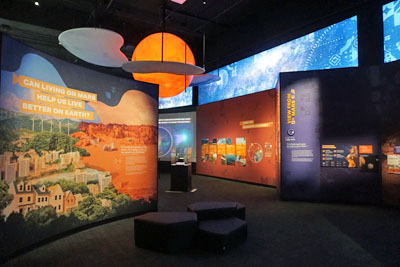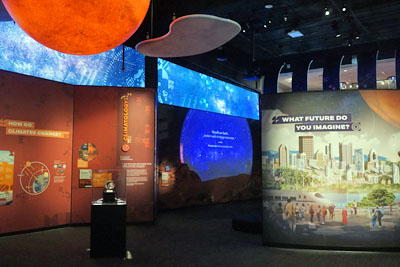
When you think of Mars, what’s the first thing to comes to mind? Matt Damon left behind on the planet’s surface in The Martian, forced to find a way to survive on his own? Strange creatures invading Earth in H.G. Wells’ The War of the Worlds? The terrorist attack that set the stage for the first season of the Star Trek: The Next Generation spinoff Picard? Or maybe it’s Marvin the Martian from Looney Tunes, wondering aloud after attempting to blow-up Earth, “Where’s the kaboom?”
In November 2022, the Carnegie Science Center in Pittsburgh, Pennsylvania, set out to explore the red planet with its Mars: The Next Giant Leap exhibit. Positioning Mars as the next logical step in space exploration, the exhibit tackles the reasons for not only visiting the planet but establishing working colonies, considers the various obstacles and decisions that will need to be made in order to survive, and the role that Mars has played through the millenniums, including its appearances within popular culture.
A quote from astronaut Mae Jemison is displayed at the entrance of Mars: The Next Giant Leap – “To survive as a species on this planet, we’re going to have to see ourselves as Earthlings,” The exhibit then expands on that statement through a series of projected images of the Martian landscape in all its magnificent splendor, including illustrations depicting humans on the surface.
While Mars is now littered with arid deserts and contains a thin atmosphere and temperatures below freezing, there was a time millions of years ago when Earth and Mars were relatively the same. Both planets, for instance, experienced asteroid impacts, volcano eruptions, ice ages and greenhouse ages, and floods. Mars likewise once had a stronger atmosphere, moderate temperatures, and water.
On Earth, those ingredients provided the ideal climate for life to emerge – raising the question, could the same have once happened on Mars? Although no definitive proof that life ever existed has been found, the possibility still remain nonetheless.
The Soviet Union began sending probes to Mars in the early 1960s, while the United States launched two Viking orbiters and landers in 1975. One year later, the first images from the planet’s surface were relayed back to Earth. In more recent years, American rovers Curiosity and Perseverance have canvassed the Martian terrain, and the Carnegie Science Center allows visitors to operate two small robotic explorers on a rugged landscape to better understand the skill and precision needed to maneuver the actual rovers.
Since Mars lacks fertile soil, streams flowing with water, and insects vital to Earth’s ecosystem, a different, more sustainable way to grow food will be necessary for any human residents of the red planet. Mars: The Next Giant Leap notes that sustainability is not only important to maintaining life on Mars but Earth as well – agriculture accounts for 70 percent of our planet’s freshwater usage and 26 percent of greenhouse gas emissions.
“Thriving in Mar’s harsh environment will require new technologies and insights,” the exhibit explains. “These same innovations will help us slow climate change and live more sustainably on Earth – right now.”
The centerpiece of Mars: The Next Giant Leap is a large model of the Martian landscape dotted with human habitats built on the planet’s surface and carved into its mountains. As visitors work their way around this “sim city,” they are confronted with the various questions that need to be answered before humans can settle on Mars, including whether we should go there in the first place.
“By creating a presence on Mars, we’ll push our limits, evolve new insights, and better understand our place in the universe,” the exhibit suggests. “The cooperative effort needed to get to Mars will prove that we can take on other daunting challenges.”
“We’ve evolved to live here – nowhere else,” the counter argument states. “Besides, we have no right to alter another world. Our track record on Earth suggests that we’ll just mess it up. Simply put, we can’t afford to take care of two worlds. We must take care of Earth first.”
If the decision is ever made to colonize Mars, other questions need to be answered as well. How would a diverse community of culture and faith be instituted? What kind of educational curriculums would be taught in schools? How can these “cities” be designed to be both functional for survival and comfortable for everyday living? What about health care? Worker rights and safety? Who profits from any mined minerals? And what kind of government would oversee the settlement?
The Carnegie Science Center doesn’t answer those questions but simply raises them for consideration. Examples from science fiction are highlighted along the way, including the Prime Directive from Star Trek, the robotic workers of Wall-E, the vertical streets of The Fifth Element, the cultural norms of Dune, and the 2018 video game Surviving Mars, in which the lack of social space and recreation centers causes human inhabitants to abandon their colony. Even Marvin the Martian is given his due, but more for his comedic escapades than factual insights.
“For as long as we’ve watched the night sky, Mars has sparked wonder,” Mars: The Next Giant Leap explains. “Our ancestors associated it with supernatural powers. Peering through telescopes, we dreamed it might host Earth-like civilizations. Our robot probs have squelched that fantasy, yet raised new questions. Is there life out there? What is our role in the universe? Blasted by wind, layered by lava flows, and pummeled by meteors, Mars has slowly revealed its secrets. Someday, eyewitness explorers will see it firsthand.”
The Carnegie Science Center has crafted an exhibit that imagines what those explorers will have to endure, as well as helping to pave the way for their eventual journey.
Anthony Letizia





